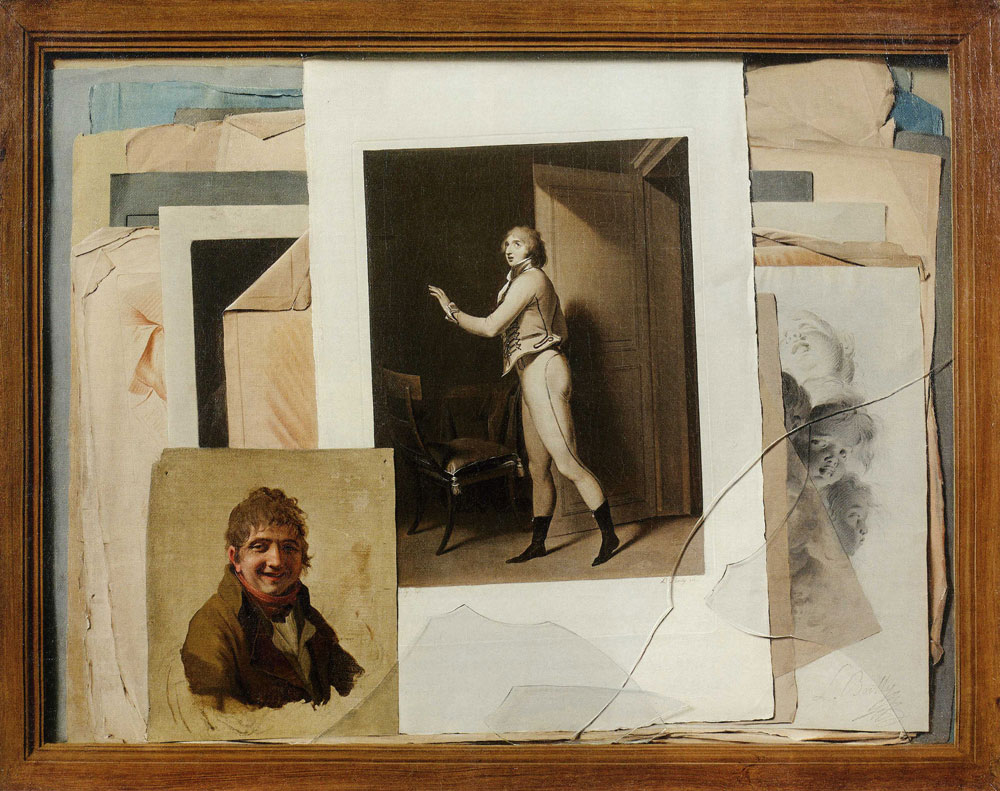 |
| Etude avec cinq autoportraits de l'artiste, vers 1823-1827 |
Louis-Léopold Boilly was a revolutionary artist, in all senses of the word. His oeuvre sits between two revolutions—those of 1789 and 1848—and so it's not surprising that he often depicts the people of the streets. Unlike painters and portraitists of his and previous generations in France, Boilly had a suspicious view of the bourgeoisie, the police, the army. His real subject matter was everyday life. Moreover, it was everyday life on the streets of the city.
Most exciting about Boilly's painting was his thirst for new technologies and what they could bring to painting. I knew enough about his work from the pieces in the Louvre to know that he was pushing at the boundaries between painting and theatre, but what is revealed in full scale over and over again in this current exhibition at the Musée Cognacq-Jay is the way that Boilly looked forward to the cinematic image.
 |
| La prison des Madelonnettes, rue des Fontaines, 1815-1819 |
In painting after painting, Boilly plays with what will become the defining characterstic of the cinema two hundred years later. His figures look from different perspectives, in motion, in scenes that give the illusion of motion. In Le prison des Madelonnettes, rue des Fontaines, for example, he juxtaposes light and shadow in the two halves of the painting and each is filled with people and their pursuit of morally good and bad activities respectively. Looking at this work, we also get a sense of a developing narrative unfolding across the width of a painting, statues being brought to life, in two halves that are like scenes whose relationship is only established in the image itself.
 |
| Jean qui rit et Jean qui pleure, vers 1808-1810 |
Visitors to the exhibition will also notice that Boilly was fascinated with illusion, with effect, with expression as a way to attract a response. There are doublings and mirrorings everywhere in his work. His figures have exquisitely painted faces filled with emotions and expressions, the fabrics of their clothes are so textured that we want to touch them. But the bodies are often distorted, misshapen, slightly out of proportion. It is as if they are being seen through a distorting lens. And then in the final room of the exhibition, there is the object that the whole thing has been moving towards: a camera obscura and a selection of early optical toys—a zograscope, telescope, a pantographe. These are the instruments Boilly used to see the world differently, through new optics, that he then translated into painting. It's easy to imagine that had Boilly lived one hundred years later, he might have turned to the cinema for his artistic expression.
 |
| Un Trompe l'oeil, detail, vers 1800 |
Perhaps the reason that Boilly is not as well known today is his diversity and range. He moved from portraits to genre paintings, to city scapes, trompe l'oeil, caricatures and still life. Boilly never sat still long enough to develop a reputation for anything. Similarly, he painted the kinds of people that the salons had no interest in: prostitutes, criminals, poor artists such as himself, those mixed up in the hustle and bustle of the train station. In this, his voracious appetite for experimentation and innovation made him so far ahead of his time that no one would have known what to do with him.
 |
| La Marche Incroyable, vers 1797 |
Ultimately, this lovely exhibition shows Boilly to be a man of his age, but as such, he is a man ahead of his time. Boilly was inspired by streets taken over by masses of people, by train stations and street dwellers. And he was interested in depicting his modern world through the instruments of his time. He blurred the boundaries between mediums where painting and photography (hence the grey of his works) and sculpture are brought to life. His depictions of theatre in the streets, together with multi-perspectival pictures that preface the cinema made him a man reaching for modernity on the streets of Paris, even before it had fully arrived.









